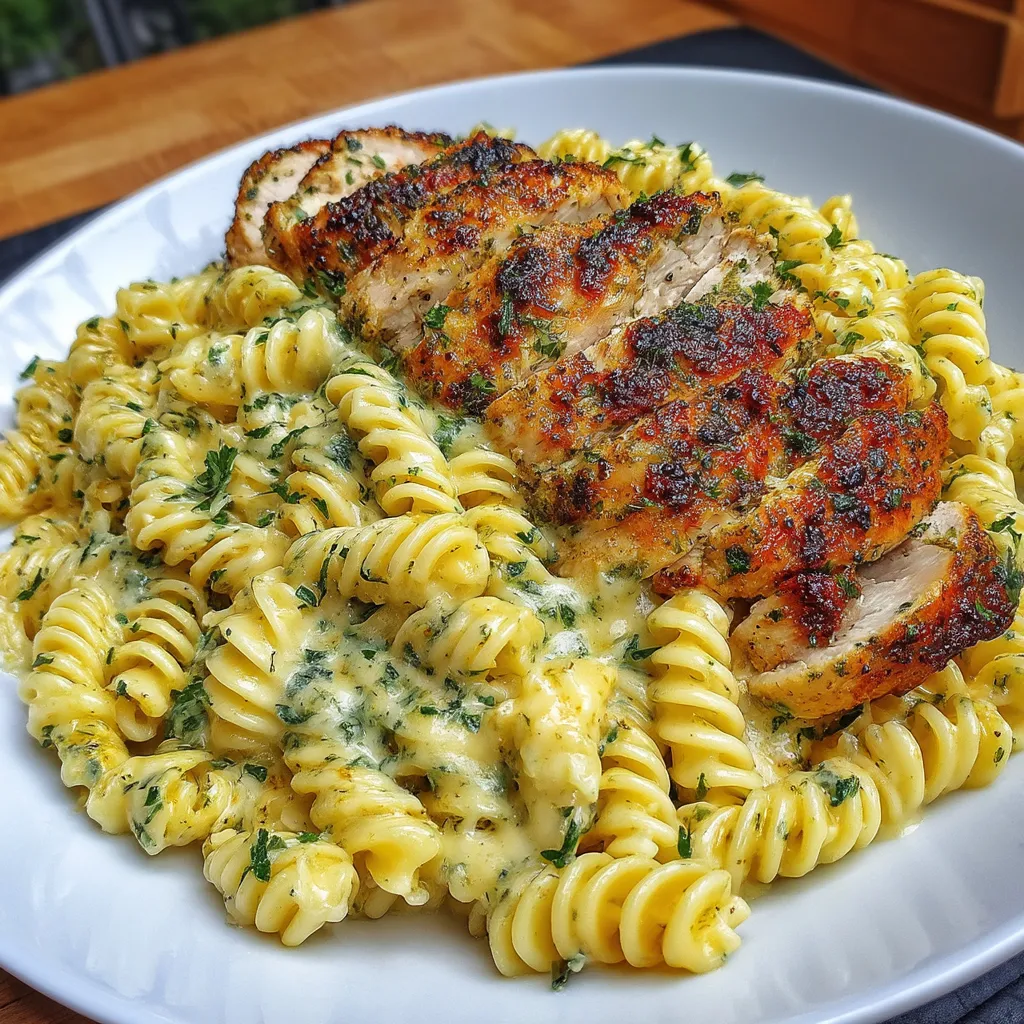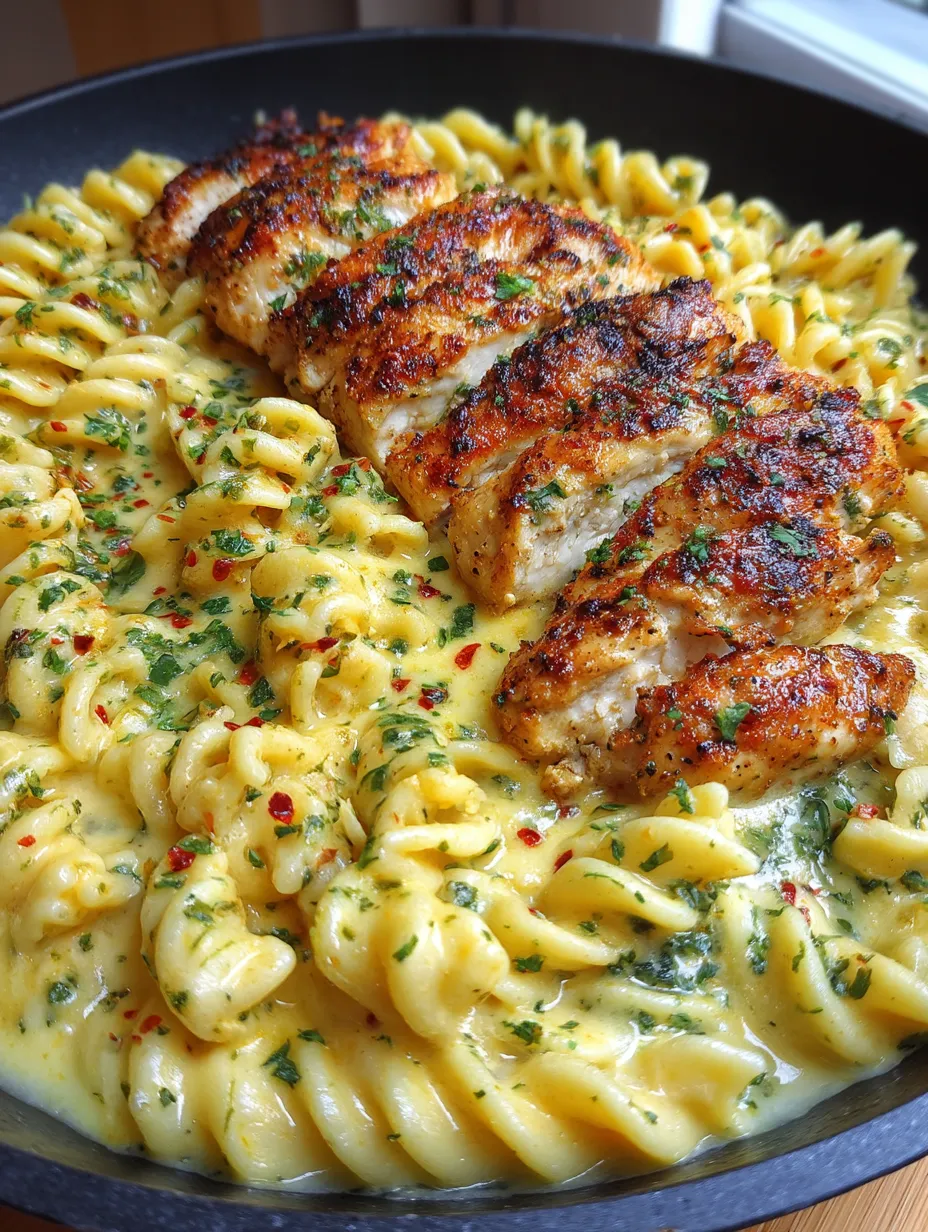 Pin it
Pin it
I stumbled across this recipe last winter during that weird week between Christmas and New Year's when everyone's tired of holiday food but not quite ready for January salads. What started as pantry desperation has become our family's most requested comfort meal. There's something magical about the combination of tender chicken and twisty pasta all coated in that velvety garlic Parmesan sauce. The way the sauce clings to every ridge and curve of the rotini creates this perfect bite where each forkful delivers the ideal balance of pasta, protein, and creamy goodness. It's like someone took all the best elements of fettuccine Alfredo and kicked them up several delicious notches.
My neighbor Sarah stopped by unexpectedly right as I was plating this up and the look on her face when she saw it told me everything. After one bite, she immediately asked for the recipe, saying her "picky eater husband" would actually eat this. Two weeks later, she texted me a photo of her empty skillet with the caption "Third time making this. Still no leftovers." When a recipe converts even dedicated picky eaters, you know you've hit culinary gold.
Perfect Ingredients
Twisted pasta provides the ideal vehicle for capturing that luscious sauce in every ridge and curl. The architectural advantage of rotini or fusilli means more sauce in every bite compared to flat noodles.
Chicken breast sliced properly creates tender, quick cooking protein that soaks up all those amazing flavors. The slicing technique prevents the dry, overcooked chicken that often plagues pasta dishes.
Heavy cream forms the luxurious base of the sauce, creating that silky mouthfeel that defines great comfort food. Its higher fat content prevents curdling when mixed with the acidic cheese.
Three cheese blend might seem excessive until you taste how each contributes something unique – Parmesan for salty depth, cream cheese for velvety body, and mozzarella for that irresistible stretch.
Reserved pasta water contains essential starch that helps bind the sauce to the pasta. This often overlooked ingredient is the secret to restaurant quality pasta that never feels greasy or separated.
 Pin it
Pin it
Step-by-Step Instructions
- Cooking pasta al dente
- ensures it will finish perfectly in the sauce without becoming mushy. That slight firmness provides textural contrast to the creamy sauce.
- Searing chicken properly
- creates golden exterior that contributes flavor while sealing in juices. Those caramelized bits left in the pan become part of the sauce, adding depth throughout.
- Sautéing garlic carefully
- unlocks its aromatic compounds without burning, which would create bitterness. This brief cooking in butter creates the aromatic foundation for the entire dish.
- Creating emulsion by slowly incorporating cheeses
- prevents graininess or separation. The gradual melting process maintains the sauce's smooth, silky texture.
- Returning chicken and pasta to the sauce
- allows them to absorb flavor while contributing starches that further thicken the sauce. This finishing step transforms separate components into cohesive dish.
- Allowing brief simmer before serving
- lets flavors meld while sauce reaches perfect consistency. Those few minutes of patience make the difference between good and transcendent.
- Tasting before serving
- ensures proper seasoning, as cheese can vary greatly in saltiness. This final check prevents the disappointment of an under seasoned creamy dish.
My first attempt at this recipe taught me valuable lessons about heat management. I initially had the burner too high when adding the cheeses, resulting in a separated, oily mess rather than a smooth sauce. The current method of lowering the heat creates perfect emulsion every time. Another game changing discovery was using twisted pasta instead of fettuccine – those spirals capture sauce in ways flat noodles simply can't, creating more flavor in every bite.
Perfect Pairings
Simple sides complement this rich main dish perfectly. Roasted broccoli provides vibrant green contrast and nutritional balance while soaking up any extra sauce deliciously. Garlic bread offers the perfect vehicle for capturing any sauce left on your plate – no waste allowed! For dinner party serving, a simple arugula salad with lemon vinaigrette cuts through the richness with bright acidity. When enjoying as casual family dinner, a glass of unoaked chardonnay for adults perfectly balances the creamy richness.
Creative Adaptations
Protein variations transform this flexible format. Shrimp creates elegant seafood version when sautéed just until pink before setting aside. Italian sausage offers deeper flavor profile when browned and sliced in place of chicken. Vegetable additions boost nutritional value – sautéed mushrooms bring umami depth, while peas or spinach add color and freshness. Heat level adjustments satisfy different preferences – increase red pepper flakes for spice lovers or omit entirely for sensitive palates.
Keeping Fresh
Storage strategies maintain quality for quick future meals. Refrigerating in airtight container keeps leftovers fresh for up to three days. Reheating works best on stovetop over low heat with splash of milk to revive the sauce. Freezing isn't recommended as cream based sauces tend to separate when thawed. Meal prep components can be prepared separately – cook chicken and pasta ahead, then make fresh sauce when ready to serve for best results.
 Pin it
Pin it
This creamy garlic Parmesan chicken and cheesy twisted pasta has become our family's reliable solution for those evenings when we need serious comfort without serious effort. The combination of tender chicken, perfectly cooked pasta, and that luxurious three cheese sauce creates something that satisfies deep cravings while still being doable on a weeknight. While not particularly revolutionary, it hits that perfect sweet spot between familiar and special that makes dinner something to look forward to rather than just another chore. Sometimes the best recipes aren't about culinary innovation but rather perfecting the classics in ways that make them both accessible and exceptional.
Frequently Asked Questions
- → Can I use a different type of pasta?
- Absolutely! While twisted shapes like rotini or fusilli are ideal because the sauce clings to all the ridges, you can substitute with penne, farfalle, or even fettuccine. Just cook according to package directions until al dente.
- → How can I make this dish lighter?
- For a lighter version, substitute half-and-half for the heavy cream, use light cream cheese, and reduce the amount of cheese by about 1/3. You can also add more vegetables like spinach, peas, or broccoli to balance the richness.
- → Can I use chicken thighs instead of breasts?
- Yes! Boneless, skinless chicken thighs work wonderfully in this recipe and often stay more tender and juicy. The cooking time may be slightly longer, so ensure they reach 165°F internal temperature before removing from the pan.
- → What's the best way to reheat leftovers?
- Reheat leftovers in a covered skillet over medium-low heat, adding a splash of milk or chicken broth to loosen the sauce as it tends to thicken when refrigerated. Stir frequently until heated through. Microwave reheating works too, but the stovetop method prevents the pasta from becoming rubbery.
- → Can I freeze this dish?
- Cream-based pasta dishes generally don't freeze well as they can separate upon thawing. If you need to freeze it, do so before adding the pasta, then cook fresh pasta when reheating the sauce. The dish will keep in the refrigerator for 3-4 days.
